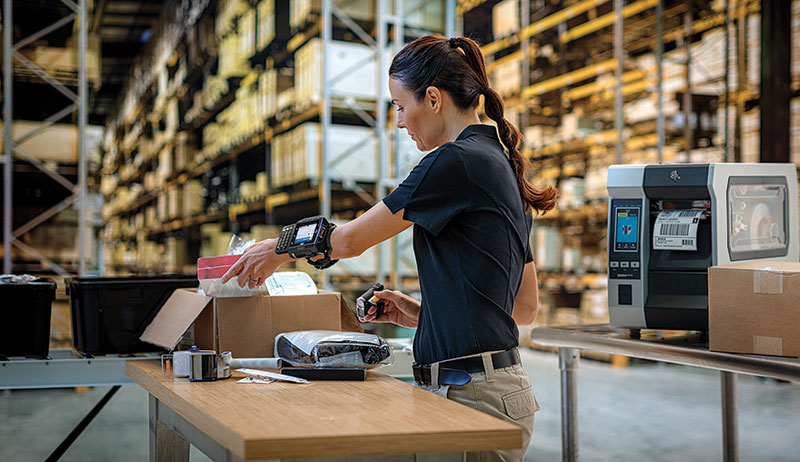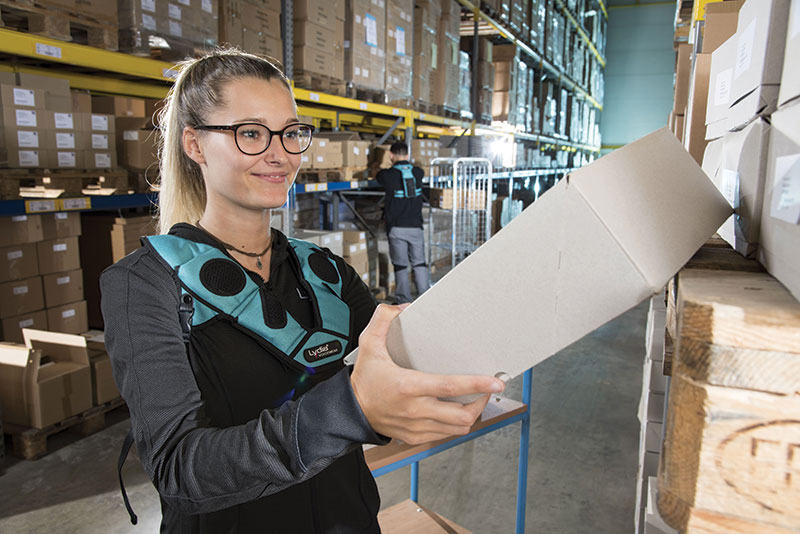Voice stands tall in the warehouse
A market that’s growing at a rate of 14.7% annually, the voice picking sector continues to innovate to meet the needs of today’s warehouses and distribution centers.
With product moving through the world’s warehouses faster than ever, labor shortages persisting and customer preferences continually changing, more companies are turning to technology for help managing these and other realities. An operational area that’s ripe for improvement, in many cases, the warehouse or DC floor is one place where organizations are applying technology to help eliminate bottlenecks, enhance efficiency and make jobs safer and easier for their employees.
For help on the order-picking front, companies are turning to one of the warehouse’s long-time allies: voice picking. Used in warehouses and DCs worldwide, voice combines real-time communication, interactive voice response and speech synthesis to create a hands-free and eyes-free picking environment.
Through portable voice terminals, headsets and other types of wearables, employees use the directions to navigate the facility and pick orders without the need for button pressing or screen reading. This, in turn, helps increase accuracy in the product picking process, enhance productivity and improve worker efficiency.
These and other benefits make voice an attractive choice for a range of fulfillment centers—so much so that the global voice picking solution market is on track to reach $3 billion in sales by 2025 (up from $1.2 billion in 2018), and posting a compound annual growth rate (CAGR) of 14.7%, according to a 2019 report from Grand View Research.

New options
As the voice market has matured and as business conditions have shifted, companies are asking for different things from their voice picking solutions.
This year, Dan Hanrahan, CEO at Numina Group, says organizations want integrated voice and messaging included in their solutions. This is happening because more companies have invested in wearable computers or “mobile terminals” that can include a message display.
This approach helps companies get the best of both worlds, so to speak. Workers are directed to specific picking locations with a series of voice commands, and then receive additional messaging on their screens once they arrive there and start the picking process.
“They have voice and hands-free bar code scanning, which companies are asking for right now in the form of wearable scanners or devices,” Hanrahan says. “Then, when the employees get to the location, they can be redirected to scan, validate the location, validate the SKU or take some other action.”
Hanrahan says Numina has also added more sensors and vibration capabilities to its products. That way, employees can be alerted to changing situations, errors or new requirements while improving accuracy. “When someone scans the wrong location or incorrect product,” he explains, “they get a vibration and are prompted to look at their message display and then address the issue.”
In general, Hanrahan says voice helps to “take the thinking out” of the picking process and eliminates the need for paper-based directions. “Around 90% of the time the picking could be voice only and the worker doesn’t even need to know which specific order they’re working on,” says Hanrahan. “They get a step-by-step sequence to validate the work, which in turn becomes uniform across the whole team.”
Numina is also integrating more voice with autonomous mobile picking applications and is using voice to direct the human workers and the robots simultaneously. In a batch cart picking application, for instance, the mobile robot can pick up a large mobile cart, bring it to a specific location in the warehouse, and direct the worker to meet the robot at that location. “We’re not pushing the cart; we’re looking for the closest available worker and then directing that employee to the pick location,” Hanrahan points out.

Comparing this “smart picking” approach to manual batch pick carts—where the operator is physically moving the cart—Hanrahan says pick rates can go as high as 250 per operator (versus 150 to 160 for the more traditional process). It also reduces cart travel requirements and boosts productivity by “driving the work and integrating voice directed picking, in combination with moving autonomous mobile robots,” he adds. “This is a big advancement that we’ve implemented in the last two years.”
Technology refresh
According to Scott Deutsch, president at Ehrhardt + Partner, Americas (EPG), the use of Android in the business setting is “changing everything” about the voice picking sector right now. “Companies are changing their overall infrastructures and using this time to determine whether there are also other opportunities to improve processes, reduce costs and improve efficiencies,” he says.
As they go through these “technology refresh” cycles, companies are also factoring in the current labor situation and finding new ways to retain their workers in an environment where unemployment is low and the “Great Resignation” is still very much in full swing. “Retention is the top HR initiative for every company right now,” says Deutsch.
“People are assessing their infrastructures and seeing what they can do from a technology platform perspective to attract and retain workers,” he adds. Many of them are finding the answers in modern voice technology platforms that incorporate advanced voice recognition engines developed by companies like EPG, which two years ago began using neural network-driving computing similar to that of Alexa and Google Home.
“This computing power allows our voice recognition engine to make life easier for workers that use it,” says Deutsch, who also sees growing interest in wearables like the EPG’s Lydia VoiceWear vest, which includes built-in microphones and speakers, versus more traditional voice headsets.
“End users want a better experience, and in a world where the focus is on worker retention, being able to offer a positive experience is critical,” says Deutsch. “Replacing headsets with vests is one way to make employees happy to be there.”
Deutsch says voice picking also enables a more diverse workforce in that it can be adapted for many different languages—and sometimes for two languages at once. In a workplace where a blend of the words and grammar of two languages may be commonly used (for example, Spanglish), voice recognition technology has advanced to the point where it can be programmed to recognize the “loanwords” across those two languages. It can also quickly adapt to new requirements when, say, an influx of new individuals from another country enter the workforce.
“This past year, we had multiple customers nationwide asking us to add language support for various Afghan dialects,” says Deutsch, who sees the universality of voice as yet another way to make workers feel comfortable and have a good experience at work. In today’s tight labor market, being able to accommodate workers in their native languages can go a long way in keeping them on board for a longer duration.
Overcoming obstacles
The main premise behind voice picking technology hasn’t changed much in the last few years as companies invest in solutions that help employees stay productive and engaged while on the job.
What has changed, according to Mark Wheeler, Zebra’s director of supply chain solutions, is the blending of voice with vision to create a more multi-dimensional experience for the user.
“Our wearable display partners well with voice because it presents certain information visually while also having that dialogue with the user with voice,” says Wheeler, who also sees more voice being used as a modality for workflows that are increasingly integrated with mobile robots. This is particularly true for the grocery and food service space, where voice supports fast-paced operations by presenting information to users who are in motion.
In assessing how far voice technology has advanced in recent years and how far it still may have to go, Wheeler says memorization is a continual challenge that may be solved through the use of wearable bar code scanners.
For example, it’s common for voice applications to confirm that the user is in the right location by reading a randomly assigned check digit or three-letter word. “The system says, ‘okay, that’s the right location, grab five of that product,’” says Wheeler. “That’s all great until the pickers memorize those check digits, which they can do surprisingly quickly.”
Wheeler also points to the introduction of robotics—which are often relied upon to accelerate operating rates—as another potential sticking point for voice in the future. The operation that was handling 50 picks per hour and then doubles the rate using robots to manage the travel and material movement, may have to rethink its voice picking approach.
“If you’re suddenly picking twice as much and twice as fast,” says Wheeler, “is voice still the right match for that workflow?” This is one of several questions that the industry will have to figure out over the next few years as autonomous mobile robots make their way into more operations and workflows.
Voice in the Cloud
Looking ahead, Hanrahan says other areas where voice is emerging as a key enabler is in the direction of pallet-building applications anywhere consolidation is required (for example, for less-than-truckload shipments).
“Being able to scan and direct pallet-building and the capture of pallet content is a big area where we’re seeing more interest,” says Hanrahan, who also sees the “voice to a Cloud” movement garnering more interest from companies right now.
“A subscription service company that has a remote warehouse and that doesn’t want to invest in servers and infrastructure may want a voice application that’s delivered in that Cloud,” says Hanrahan. “That’s one more area that we’re pushing forward in right now.”













